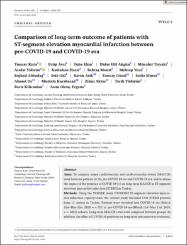Comparison of long-term outcome of patients with ST-segment elevation myocardial infarction between pre-COVID-19 and COVID-19 era

Göster/
Erişim
info:eu-repo/semantics/openAccessTarih
2022Yazar
Kiris, TuncayAvcı, Eyüp
Ekin, Tuba
Akgün, Didar Elif
Tiryaki, Mücahit
Yidirim, Arafat
Hazır, Kutluhan
Murat, Bektaş
Üst veri
Tüm öğe kaydını gösterÖzet
Aims: To compare major cardiovascular and cerebrovascular events (MACCE) rates between patients in the pre-COVID-19 era and COVID-19 era, and to assess the impact of the presence of COVID-19 (+) on long-term MACCE in ST-segment elevation myocardial infarction (STEMI) in Turkey.
Methods: Using the TURSER study (TURKISH ST-segment elevation myocardial infarction registry) data, the current study included 1748 STEMI patients from 15 centres in Turkey. Patients were stratified into COVID-19 era (March 11st-May 15st, 2020; n = 723) or pre-COVID-19 era (March 11st-May 15st, 2019; n = 1025) cohorts. Long-term MACCE rates were compared between groups. In addition, the effect of COVID-19 positivity on long-term outcomes was evaluated. The primary outcome was the occurrence of MACCE at long-term follow-up, and the secondary outcome was hospitalization with heart failure.
Results: The MACCE and hospitalization with heart failure rates between pre-COVID-19 era and COVID-19 era were 23% versus 22% (p = .841), and 12% versus 8% (p = .002), respectively. In the COVID-19 era, the rates of MACCE and hospitalization with heart failure COVID-19-positive versus COVID-19-negative patients were 40% versus 20%, (p < .001), and 43% versus 11% (p < .001), respectively.
Conclusion: There was no difference between the pre-COVID-19 era and the COVID-19 era in terms of MACCE in STEMI patients in Turkey. In the COVID-19 era, STEMI patients positive for COVID-19 had a higher rate of MACCE and heart failure hospitalization at the long-term follow-up.

















